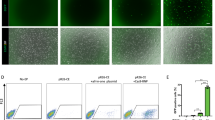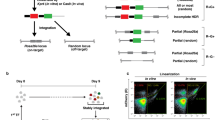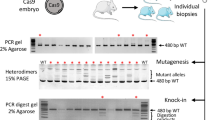Abstract
We have investigated the use of single-stranded oligodeoxy-nucleotides (ssODN) to produce specific single-base alterations in episomal and chromosomal DNA in mouse embryonic stem (ES) cells. Two different reporter genes, EGFP and LacZ, each with a single point mutation that inactivates reporter activity, were used. ssODN homologous to the target sequence, except for a single mismatch at the mutant base, were used to correct the mutant reporter genes. When tested in CHO-K1 cells, the ssODN showed correction rates of 0.5–1.0%, consistent with prior reports. ssODN in the antisense orientation provided higher rates of gene conversion than those in the sense orientation for both reporter genes. Nuclear extracts from mouse ES cells exhibited nearly the same correction activity as extracts from CHO-K1 cells. ssODN corrected the mutant bases of both episomal and chromosomal mutant reporter genes in mouse ES cells. Although the efficiency of gene correction observed in ES cells is low, approximately 10−4, these results demonstrate that ssODN can produce single-base alterations in the genomic DNA of mouse ES cells. As conversion efficiency is improved by the continued development of oligonucleotide structure and DNA delivery methods, ssODN could be used to produce ES cells with specific mutations in any gene in a single step. The targeted ES cells could in turn be used to create accurate mouse models of inherited diseases.
This is a preview of subscription content, access via your institution
Access options
Subscribe to this journal
Receive 12 print issues and online access
$259.00 per year
only $21.58 per issue
Buy this article
- Purchase on Springer Link
- Instant access to full article PDF
Prices may be subject to local taxes which are calculated during checkout







Similar content being viewed by others
References
Thomas KR, Capecchi MR . Site-directed mutagenesis by gene targeting in mouse embryo-derived stem cells. Cell 1987; 51: 503–512.
Muller U . Ten years of gene targeting: targeted mouse mutants, from vector design to phenotype analysis. Mech Dev 1999; 82: 3–21.
Nagy A . Cre recombinase: the universal reagent for genome tailoring. Genesis 2000; 26: 99–109.
Doetschman T et al. Targetted correction of a mutant HPRT gene in mouse embryonic stem cells. Nature 1987; 330: 576–578.
Metzger D, Chambon P . Site- and time-specific gene targeting in the mouse. Methods 2001; 24: 71–80.
Copp AJ . Death before birth: clues from gene knockouts and mutations. Trends Genet 1995; 11: 87–93.
Olson EN, Arnold HH, Rigby PW, Wold BJ . Know your neighbors: three phenotypes in null mutants of the myogenic bHLH gene MRF4. Cell 1996; 85: 1–4.
Wang Y et al. A mouse model for achrondroplasia produced by targeting fibroblast growth factor receptor 3. Proc Natl Acad Sci USA 1999; 96: 4455–4460.
Hadjantonakis AK, Pirity M, Nagy A . Cre recombinase mediated alterations of the mouse genome using embryonic stem cells. Methods Mol Biol 1999; 97: 101–122.
Loonstra A et al. Growth inhibition and DNA damage induced by Cre recombinase in mammalian cells. Proc Natl Acad Sci USA 2001; 98: 9209–9214.
Moerschell RP, Tsunasawa S, Sherman F . Transformation of yeast with synthetic oligonucleotides. Proc Natl Acad Sci USA 1988; 85: 524–528.
Campbell CR et al. Homologous recombination involving small single-stranded oligonucleotides in human cells. New Biol 1989; 1: 223–227.
Yamamoto T et al. Strand-specificity in the transformation of yeast with synthetic oligonucleotides. Genetics 1992; 131: 811–819.
Majumdar A et al. Targeted gene knockout mediated by triple helix forming oligonucleotides. Nat Genet 1998; 20: 212–214.
Havre PA, Gunther EJ, Gasparro FP, Glazer PM . Targeted mutagenesis of DNA using triple helix-forming oligo-nucleotides linked to psoralen. Proc Natl Acad Sci USA 1993; 90: 7879–7883.
Luo Z, Macris MA, Faruqi AF, Glazer PM . High-frequency intrachromosomal gene conversion induced by triplex-forming oligonucleotides microinjected into mouse cells. Proc Natl Acad Sci USA 2000; 97: 9003–9008.
Culver KW et al. Correction of chromosomal point mutations in human cells with bifunctional oligonucleotides. Nat Biotechnol 1999; 17: 989–993.
Vasquez KM, Narayanan L, Glazer PM . Specific mutations induced by triplex-forming oligonucleotides in mice. Science 2000; 290: 530–533.
Yoon K, Cole-Strauss A, Kmiec EB . Targeted gene correction of episomal DNA in mammalian cells mediated by a chimeric RNA. DNA oligonucleotide. Proc Natl Acad Sci USA 1996; 93: 2071–2076.
Alexeev V, Yoon K . Stable and inheritable changes in genotype and phenotype of albino melanocytes induced by an RNA–DNA oligonucleotide. Nat Biotechnol 1998; 16: 1343–1346.
Cole-Strauss A et al. Correction of the mutation responsible for sickle cell anemia by an RNA–DNA oligonucleotide. Science 1996; 273: 1386–1389.
Kren BT, Cole-Strauss A, Kmiec EB, Steer CJ . Targeted nucleotide exchange in the alkaline phosphatase gene of HuH-7 cells mediated by a chimeric RNA/DNA oligonucleotide. Hepatology 1997; 25: 1462–1468.
Kren BT et al. Correction of the UDP-glucuronosyltransferase gene defect in the Gunn rat model of Crigler–Najjar syndrome type I with a chimeric oligonucleotide. Proc Natl Acad Sci USA 1999; 96: 10349–10354.
Alexeev V et al. Localized in vivo genotypic and phenotypic correction of the albino mutation in skin by RNA–DNA oligonucleotide. Nat Biotechnol 2000; 18: 43–47.
Rando TA, Disatnik MH, Zhou LZ . Rescue of dystrophin expression in mdx mouse muscle by RNA/DNA oligonucleotides. Proc Natl Acad Sci USA 2000; 97: 5363–5368.
Bartlett RJ et al. In vivo targeted repair of a point mutation in the canine dysrophin gene by a chimeric RNA/DNA oligonucleotide. Nat Biotechnol 2000; 18: 615–622.
Santana E et al. Different frequency of gene targeting events by the RNA–DNA oligonucleotide among epithelial cells. J Invest Dermatol 1998; 111: 1172–1177.
Igoucheva O, Petriz AE, Levy D, Yoon K . A sequence-specific gene correction by an RNA–DNA oligonucleotide in mammalian cells characterized by transfection and nuclear extract using a LacZ shuttle system. Gene Ther 1999; 6: 1960–1971.
Gamper HB et al. The DNA strand of chimeric RNA/DNA oligonucleotides can direct gene repair/conversion activity in mammalian and plant cell-free extracts. Nucleic Acids Res 2000; 28: 4332–4339.
Igoucheva O, Alexeev V, Yoon K . Targeted gene correction by small single-stranded oligonucleotides in mammalian cells. Gene Ther 2001; 8: 391–399.
Liu L, Rice MC, Kmiec EB . In vivo gene repair of point and frameshift mutations directed by chimeric RNA/DNA oligonucleotides and modified single-stranded oligonucleotides. Nucleic Acids Res 2001; 29: 4238–4250.
Cole-Strauss A et al. Targeted gene repair directed by the chimeric RNA/DNA oligonucleotide in a mammalian cell-free extract. Nucleic Acids Res 1999; 27: 1323–1330.
Ramirez-Solis R, Davis AC, Bradley A . Gene targeting in embryonic stem cells. Methods Enzymol 1997; 225: 855–878.
Abuin A, Zhang H, Bradley A . Genetic analysis of mouse embryonic stem cells bearing Msh2 and Msh3 single and compound mutations. Mol Biol Cell 2000; 20: 149–157.
Yang TT, Cheng L, Kain SR . Optimized codon usage and chromophore mutations provide enhanced sensitivity with the green fluorescent protein. Nucleic Acids Res 1996; 24: 4592–4593.
Cormack BP, Valdivia RH, Falkow S . FACS-optimized mutants of the green fluorescent protein (GFP). Gene 1996; 173: 33–38.
Hunger-Bertling K, Harrer P, Bertling W . Short DNA fragments induce site specific recombination in mammalian cells. Mol Cell Biochem 1990; 92: 107–116.
Goncz KK, Kunzelmann K, Xu Z, Gruenert DC . Targeted replacement of normal and mutant CFTR sequences in human airway epithelial cells using DNA fragments. Hum Mol Genet 1998; 7: 1913–1919.
Russell DW, Hirata RK . Human gene targeting by viral vectors. Nat Genet 1998; 18: 325–330.
Thyagarajan B, Guimaraes MJ, Groth AC, Calos MP . Mammalian genomes contain active recombinase recognition sites. Gene 2000; 244: 47–54.
Doestschman T, Maeda N, Smithies O . Targeted mutation of the Hprt gene in mouse embryonic stem cells. Proc Natl Acad Sci USA 1988; 85: 8583–8587.
Deng C, Capecchi MR . Reexamination of gene targeting frequency as a function of the extent of homology between the targeting vector and the target locus. Mol Cell Biol 1992; 12: 3365–3371.
Ramirez-Solis R, Liu P, Bradley A . Chromosome engineering in mice. Nature 1995; 378: 720–724.
Matise MP, Auerbach W, Joyner AL . Production of targeted embryonic stem cell lines. In: Joyner AL (ed.). Gene Targeting: A Practical Approach. Oxford University Press: Oxford, 2000, pp. 101–132.
Labosky PA et al. The winged helix gene, Mf3, is required for normal development of the diencephalon and midbrain, postnatal growth and the milk-ejection reflex. Development 1997; 124: 1263–1274.
Nagy A et al. Derivation of completely cell culture-derived mice from early-passage embryonic stem cells. Proc Natl Acad Sci USA 1993; 90: 8424–8428.
Subramanian A, Ranganathan P, Diamond SL . Nuclear targeting peptide scaffolds for lipofection of nondividing mammalian cells. Nat Biotechnol 1999; 17: 873–877.
Boussif O et al. A versatile vector for gene and oligonucleotide transfer into cells in culture and in vivo: polyethylenimine. Proc Nat Acad Sci USA 1995; 92: 7297–7301.
Sambrook J, Fritsch EF, Maniatis T . Molecular Cloning: A Laboratory Manual. Cold Spring Harbor Laboratory Press: Plainview, NY, 1989.
Acknowledgements
The authors thank Suzanne Pavluk, David Pugh and Maithili Navarathnarajah for technical assistance, and Drs Jean Bennett and Edward Pugh for helpful discussions. Supported in part by grants from the National Institutes of Health (EY13776, GM61942, HL66656, AR44350), Research to Prevent Blindness, the Rosanne H Silbermann Foundation, the Mackall Foundation Trust and the FM Kirby Foundation.
Author information
Authors and Affiliations
Rights and permissions
About this article
Cite this article
Pierce, E., Liu, Q., Igoucheva, O. et al. Oligonucleotide-directed single-base DNA alterations in mouse embryonic stem cells. Gene Ther 10, 24–33 (2003). https://doi.org/10.1038/sj.gt.3301857
Received:
Accepted:
Published:
Issue Date:
DOI: https://doi.org/10.1038/sj.gt.3301857
Keywords
This article is cited by
-
Progress and prospects: oligonucleotide-directed gene modification in mouse embryonic stem cells: a route to therapeutic application
Gene Therapy (2011)
-
Genetic correction of splice site mutation in purified and enriched myoblasts isolated from mdx5cv mice
BMC Molecular Biology (2009)
-
Single-strand DNA-mediated targeted mutagenesis of genomic DNA in early mouse embryos is stimulated by Rad51/54 and by Ku70/86 inhibition
Gene Therapy (2008)
-
Site-specific gene modification by oligodeoxynucleotides in mouse bone marrow-derived mesenchymal stem cells
Gene Therapy (2008)
-
Delivery and mechanistic considerations for the production of knock-in mice by single-stranded oligonucleotide gene targeting
Gene Therapy (2007)



